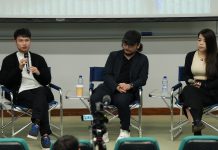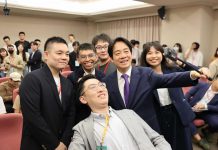Sound art is not merely something created by artists. It is an interaction between artists and the audience, and involves the public to a large extent. Tse thinks that life in Hong Kong is too hectic. Many of us put on earphones when we go to work, and when we get off work, we just watch TV dramas. Our lives are filled with this mainstream media. These habits control what we hear and we often miss out on other sounds that are worth listening to.
“If you don’t listen, sound does not exist. Only when you listen carefully will you be able to hear,” says Tse. This is the main idea behind “active listening”.
“It is when you are aware of the existence of sound, its meanings, textures or layers, that you will be able to deepen your listening ability,” he adds.
So Wai-lam, the project manager of Soundpocket, says she gained insights on listening when she was doing a course on audio at university: “It was the first time we used the audio equipment to do recording. It is interesting that it turned out I did not use any visual elements to accompany the audio tracks because I thought the audio itself was already enough [to convey the message].” Living in a visual era, we have all become so comfortable with images that we seem to have neglected the independent value of sound.
“Listening is a very important activity, everyone can participate in it, even deaf people,” says Yeung Yang, the founding member and executive director of Soundpocket. Yang cites the example of Dame Evelyn Glennie, a deaf percussionist who recently staged a concert in Hong Kong. She plays instruments depending on how she feels about the vibrations around her.
Yeung says listening is not difficult. “If you want to appreciate art, you should first get yourself ready, have the awareness that ‘I’m going to feel something now’.”
Soundpocket organises workshops such as Sound and Poetry and Sound Collecting at their office. It is also cooporating with The Power of Words, a CUHK project promoting reading and writing, to organise a workshop called Poem and Sound. The workshops teach participants ways to practise active listening in their everyday lives. These include closing your eyes and taking a deep breath to tune your ears; focusing on the farthest and the nearest sound; then slowly sensing the mixture of sounds within the environment. These are all simple acts that anyone can perform any time and anywhere.
The participants at these workshops come from all walks of life, including teachers, company directors, bankers and IT professionals. Yeung says one participant impressed her the most. “During a soundwalk event there was this male participant,” she recalls. “At that time, we were not supposed to talk and had to listen carefully to sounds around us. But he suddenly told me that he just realised he had become so close to himself. In fact, this was an awakening for him. That moment is so touching.”
Joseph Zhan Yue-ser, an IT professional, has twice participated in Soundpocket’s workshops. He did not have too many expectations beforehand and only signed up because he received an email about the workshop.
Before the workshops, participants had to record a sound clip on their own. Zhan, who is a classical music lover thought about recording classical music but, in the end, he decided to record cicadas because he thought sounds from nature would be more touching and powerful. Zhan appreciates sound art because he believes it allows him to express himself in a way that is similar to the way composers express themselves through music.
During the workshops, there is a wide range of activities to introduce sound art including talks and sound walks. Zhan says it allowed him to appreciate the beauty of Hong Kong in a different way and inspired him to collect different types of sound.
After the workshops, he continued to record different sounds in his everyday life and he is now a sound collector for Soundpocket’s sound library.
The Library by Soundpocket collects recordings of ambient sounds and the public can browse through it online. It aims to cultivate a large number of “listeners” and promote the development of sound art.
Although the workshops and library are open to everyone, Soundpocket says they do not intend to lower the threshold of art appreciation and have no plans to turn their projects and workshops into “art for all” programmes. This is partly due to limited resources and the lengthy application process to get government permission to use the streets and parks as performance or workshop sites and partly because they want to maintain standards.
“Not anyone who records sound can be called artistic, but no one knows if he will eventually be able to deepen this recording practice and become an artist,” says Yang. However, she says developing good appreciation skills is a worthy goal in itself.
In a small crowded city like Hong Kong, we are not just bombarded by intense visual elements like skyscrapers and billboards, we are also surrounded by clustered and overlapping sounds. Many of us may notice and appreciate our surroundings with our eyes, but few of us truly open up our ears. If we listen carefully, we may also hear the beauty in what most people would regard as noise.
Edited by Sandy Ho







































